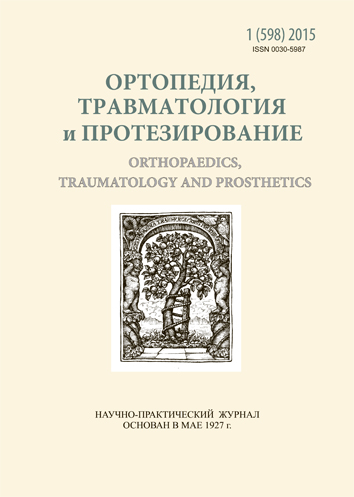Radiological signs of «hidden» fracture-dislocations of elbow
DOI:
https://doi.org/10.15674/0030-59872015163-66Keywords:
elbow, «hidden»fracture-dislocation, radiological signAbstract
It is proved that there are fracture-dislocations of elbow leading to spontaneous reduction of the forearm. Due to this it is likely erroneous determination of injur y and therefore inadequate treatment with unsatisfactor y results. Objective: To identify significant radiological criteria which will make it possible to define injuries of the elbow as fracture-dislocation in case of absence of radiological picture of the forearm dislocation according to results of primary radiological examination. Methods: Among 95 patients with fracture-dislocation of elbow we identified main group of 16 patients whom during primar y X-ray examination was not fixed dislocation of the forearm in (all of them had fracture of the radial head). The control group included 46 patients with trivial fractures of the radial head. The results of radiological examination of elbows were analyzed patients in both groups. Results: There were found radiological signs allowing to consider the damage as «hidden»fracture-dislocation of elbow. In 53.8 % of the patients in the main group the radial head dislocation was set as well as its rotation to about 90° and location behind the capitulum of the humerus. In 46.2 % of the patients there were found rather large head pieces (about ½ of its size) which were shifted forward, laterally, or in anterolateral direction, and besides distance of displacement is compared with the value of the piece. Conclusions: The most distinctive feature for the «hidden»fracture-dislocations is the presence of large-sized fragments of the radial head or fragments of the other bone formation with a significant shift them back and rotation to about 90° or offset forward, laterally or anterolateral direction for distance comparable to the size of fragment. Probability of «hidden»fracture- dislocation of elbow is higher in cases of fractures of the radial head type III (according to Mason classification modified by M.A. Broberg, B.F. Morrey).
References
- Маtеlеnоk Ye. М. Functional treatment of complex injuries of the elbow joint: manuscript of dis.for degree of DM/ Ye. М. Маtеlеnоk — Kharkiv, 2013. — 40 p.
- Маtеlеnоk Ye. М. Self-reduced dislocations of the foream in the structure of dislocation fractures of elbow joint / Ye. М. Маtеlеnоk, R.I.Buznitsky // Trauma. — 2014. — Vol. 15, № 3. — P. 11–14.
- Azmi I. The results of treatment of dislocation and fracturedislocation of the elbow: a review of 41 patients / I. Azmi, M. Razak, Y. Hyzan // Med. J. Malaysia. — 1998. — Vol. 53, Suppl. A. — Р. 59–70.
- Broberg M.A. Results of treatment of fracture-dislocations of the elbow / M. A. Broberg, B. F. Morrey // Clin. Orthop. Relat. Res. — 1987. — Vol. 216. — P. 109–119.
- Jeffery C. C. Fractures of the head of the radius in children / C. C. Jeffery //J. Bone Joint Surg. — 1950. — Vol. 32-В, № 3. — P. 314–324.
- Saati A. Z. Fracture-dislocation of the elbow: diagnosis, treatment, and prognosis / A. Z. Saati, M. D. McKee // Hand Clin. — 2004. — Vol. 20, № 4. — Р. 405–414.
Downloads
How to Cite
Issue
Section
License
Copyright (c) 2015 Yevgeny Matelenok

This work is licensed under a Creative Commons Attribution 4.0 International License.
The authors retain the right of authorship of their manuscript and pass the journal the right of the first publication of this article, which automatically become available from the date of publication under the terms of Creative Commons Attribution License, which allows others to freely distribute the published manuscript with mandatory linking to authors of the original research and the first publication of this one in this journal.
Authors have the right to enter into a separate supplemental agreement on the additional non-exclusive distribution of manuscript in the form in which it was published by the journal (i.e. to put work in electronic storage of an institution or publish as a part of the book) while maintaining the reference to the first publication of the manuscript in this journal.
The editorial policy of the journal allows authors and encourages manuscript accommodation online (i.e. in storage of an institution or on the personal websites) as before submission of the manuscript to the editorial office, and during its editorial processing because it contributes to productive scientific discussion and positively affects the efficiency and dynamics of the published manuscript citation (see The Effect of Open Access).














